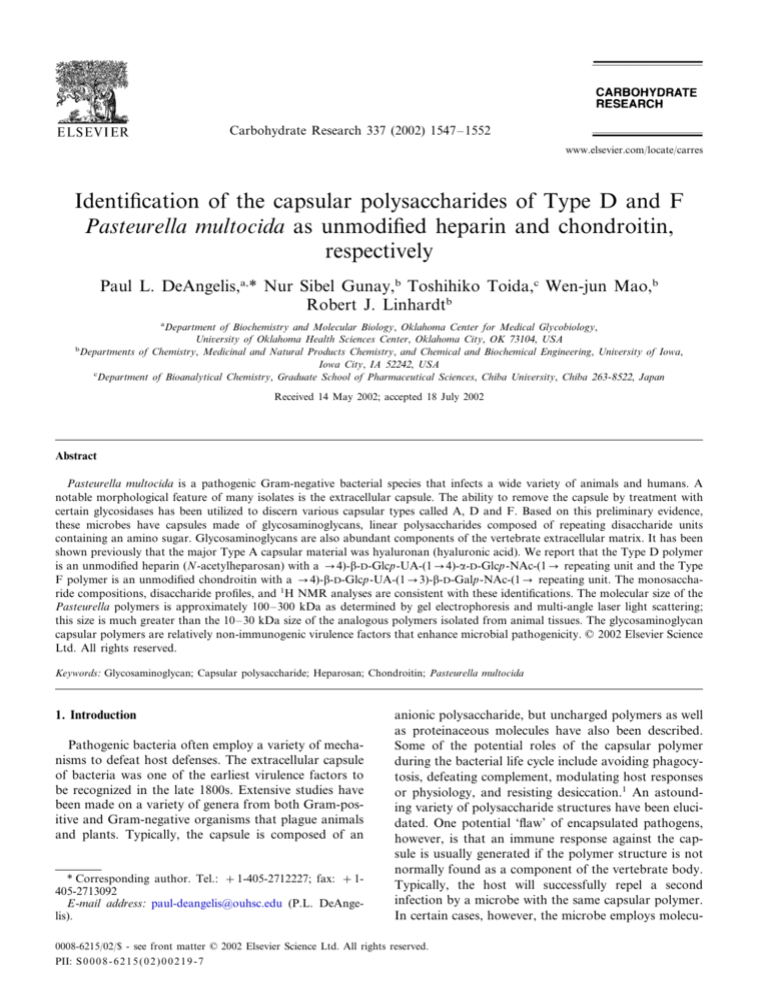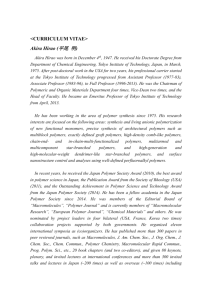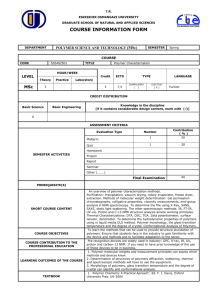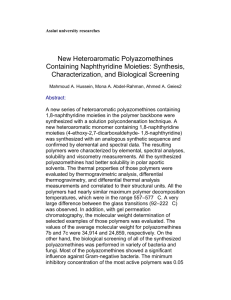
Carbohydrate Research 337 (2002) 1547 –1552
www.elsevier.com/locate/carres
Identification of the capsular polysaccharides of Type D and F
Pasteurella multocida as unmodified heparin and chondroitin,
respectively
Paul L. DeAngelis,a,* Nur Sibel Gunay,b Toshihiko Toida,c Wen-jun Mao,b
Robert J. Linhardtb
a
Department of Biochemistry and Molecular Biology, Oklahoma Center for Medical Glycobiology,
Uni6ersity of Oklahoma Health Sciences Center, Oklahoma City, OK 73104, USA
b
Departments of Chemistry, Medicinal and Natural Products Chemistry, and Chemical and Biochemical Engineering, Uni6ersity of Iowa,
Iowa City, IA 52242, USA
c
Department of Bioanalytical Chemistry, Graduate School of Pharmaceutical Sciences, Chiba Uni6ersity, Chiba 263 -8522, Japan
Received 14 May 2002; accepted 18 July 2002
Abstract
Pasteurella multocida is a pathogenic Gram-negative bacterial species that infects a wide variety of animals and humans. A
notable morphological feature of many isolates is the extracellular capsule. The ability to remove the capsule by treatment with
certain glycosidases has been utilized to discern various capsular types called A, D and F. Based on this preliminary evidence,
these microbes have capsules made of glycosaminoglycans, linear polysaccharides composed of repeating disaccharide units
containing an amino sugar. Glycosaminoglycans are also abundant components of the vertebrate extracellular matrix. It has been
shown previously that the major Type A capsular material was hyaluronan (hyaluronic acid). We report that the Type D polymer
is an unmodified heparin (N-acetylheparosan) with a 4)-b-D-Glcp-UA-(1 4)-a-D-Glcp-NAc-(1 repeating unit and the Type
F polymer is an unmodified chondroitin with a 4)-b-D-Glcp-UA-(1 3)-b-D-Galp-NAc-(1 repeating unit. The monosaccharide compositions, disaccharide profiles, and 1H NMR analyses are consistent with these identifications. The molecular size of the
Pasteurella polymers is approximately 100–300 kDa as determined by gel electrophoresis and multi-angle laser light scattering;
this size is much greater than the 10–30 kDa size of the analogous polymers isolated from animal tissues. The glycosaminoglycan
capsular polymers are relatively non-immunogenic virulence factors that enhance microbial pathogenicity. © 2002 Elsevier Science
Ltd. All rights reserved.
Keywords: Glycosaminoglycan; Capsular polysaccharide; Heparosan; Chondroitin; Pasteurella multocida
1. Introduction
Pathogenic bacteria often employ a variety of mechanisms to defeat host defenses. The extracellular capsule
of bacteria was one of the earliest virulence factors to
be recognized in the late 1800s. Extensive studies have
been made on a variety of genera from both Gram-positive and Gram-negative organisms that plague animals
and plants. Typically, the capsule is composed of an
* Corresponding author. Tel.: +1-405-2712227; fax: + 1405-2713092
E-mail address: paul-deangelis@ouhsc.edu (P.L. DeAngelis).
anionic polysaccharide, but uncharged polymers as well
as proteinaceous molecules have also been described.
Some of the potential roles of the capsular polymer
during the bacterial life cycle include avoiding phagocytosis, defeating complement, modulating host responses
or physiology, and resisting desiccation.1 An astounding variety of polysaccharide structures have been elucidated. One potential ‘flaw’ of encapsulated pathogens,
however, is that an immune response against the capsule is usually generated if the polymer structure is not
normally found as a component of the vertebrate body.
Typically, the host will successfully repel a second
infection by a microbe with the same capsular polymer.
In certain cases, however, the microbe employs molecu-
0008-6215/02/$ - see front matter © 2002 Elsevier Science Ltd. All rights reserved.
PII: S 0 0 0 8 - 6 2 1 5 ( 0 2 ) 0 0 2 1 9 - 7
1548
P.L. DeAngelis et al. / Carbohydrate Research 337 (2002) 1547–1552
lar mimicry of host molecules. This clever strategy of
utilizing relatively non-immunogenic polymers allows
multiple infections to occur because an antibody response is not mounted. Indeed, if anti-self antibodies
were generated, then potentially severe autoimmune
complications could result.
The most vivid examples of mimicry are the production of glycosaminoglycan [GAG] or GAG-like capsules.2 GAGs, linear polysaccharides with a repeating
disaccharide backbone containing an amino sugar (either GlcNAc or GalNAc), are essential components of
the extracellular matrices of animals. The vertebrate
GAGs hyaluronan [HA], heparan sulfate/heparin, and
chondroitin sulfate contain an uronic acid as the other
sugar in the repeat while keratan sulfate has a galactose. These complex molecules play important structural, adhesion, and signaling roles in mammals. Group
A and C Streptococcus and Type A Pasteurella multocida bacteria produce HA capsules; the microbial polymer is chemically identical to the vertebrate molecule,
thus virtually no immune response is generated to the
capsule. Escherichia coli K5 produces an unmodified
heparin-like molecule called heparosan or N-acetylheparosan.3 E. coli K4 produces a chondroitin-like
molecule with fructose side branches on the 3-position
of the glucuronic residues.4 In all these cases, the wildtype bacteria are more virulent than acapsular mutants.
Carter originally recognized three P. multocida capsular types called A, B, and C.5 Over time, some
revision (Type C no longer recognized) and other types
(D, E, and F) were described by Brogden, Heddleston,
Rhoades, and Rimler.6,7 As mentioned, the Type A
microbe, the major fowl cholera pathogen and a
causative agent of bovine shipping fever, produces a
hyaluronan capsule.8 Type B, the agent of hemorhagic
fever in ungulates, produces a capsule of unknown
structure composed of arabinose, mannose, and galactose. Type D isolates cause atrophic rhinitis in swine
but are sometimes isolated from other organisms. Type
E, an African serotype with a capsular polymer of
unknown structure, infects cattle and buffalo. Type F is
a minor causative agent of fowl cholera. Previous studies showed that the capsule of Type D and Type F
bacteria were removed, as judged by light microscopy,
by treatment with certain enzymes that selectively degrade GAGs. The Type D capsule was removed by
treatment with heparinase III or chondroitin AC lyase.6
The Type F capsule was removed by treatment with
chondroitin AC lyase. Unlike many other non-GAG
capsules, no typing antiserum could be generated for
Types A, D, and F. The use of the basic dye, acriflavine, to flocculate these types was sometimes used, but
the test is not robust and rather difficult to utilize by
the non-expert. Therefore, the enzyme treatment was
used as a vigorous proof to discriminate the Type D
and F isolates. A newer polymerase chain reaction
method based on the differences among genes in the
various capsular loci has been described to distinguish
the various strains,9 but the exact nature of the Type D
and F polymers was not known at the time.
In this report we utilize chemical, enzymatic, mass
spectrometric, and nuclear magnetic resonance studies
to identify definitively the Type D and Type F capsular
polysaccharides.
2. Results and discussion
The anionic capsular polymers were isolated from
culture media of spent P. multocida by precipitation
with cetylpyridinium chloride. Monosaccharide analysis
of the Type D and F polymers both yielded only a
hexosamine and a uronic acid. Type D polymer contained GlcN while Type F polymer contained GalN.
Acid hydrolysis fragments the polymer, but also removes any N-acetyl groups as well as other labile
modifications such as sulfates. Standards consisting of
heparin and chondroitin sulfate derived from animal
sources yielded very similar profiles as Type D and F,
respectively.
Size analysis of the Type D and F capsular polymers
by both gel-filtration chromatography and electrophoresis indicate that the molecular size was in the
105 Da ( 500 sugars) range. Polyacrylamide gel electrophoresis yielded apparent molecular weights of
50 –100 kDa for both polysaccharides using heparin
or chondroitin sulfate standards. Gel-filtration chromatography coupled with multi-angle laser light scattering analysis yielded average molecular weights of
330 kDa and 270 kDa for Types D and F, respectively. The sizes of the capsular polymers are substantially larger that the chains observed in these GAGs
derived from animal tissues (e.g., cartilage, trachea, and
intestinal mucosa).
1
H NMR analysis of the Type F polymer at 298 and
318 K showed that it is an unsulfated chondroitin
polymer. It consists of a 4)-b-D-Glcp-UA-(13)-bD-Galp-NAc-(1 repeating unit (Fig. 1). The region at
3.775–3.699 ppm comprises H-4, H-5 of Glcp-UA
residue and H-6 of Galp-NAc residue. The signals at
4.439, 3.595, 3.304 are H-1, H-3 and H-2 of Glcp-UA
residue and signals at 4.068 and 1.969 are H-4 and
N-acetyl methyl of Galp-NAc residue, respectively (Fig.
2(A)). Enzymatic depolymerization10 of sample with
chondroitin AC lyase and chondroitin ABC lyase, followed by CE disaccharide analysis, showed a single
peak that comigrates with DUAp-(1 3)-a,b-D-GalNAc disaccharide standard. No other peaks corresponding to chondroitin sulfate- (or dermatan sulfate-)
derived monosulfated, disulfated and trisulfated disaccharides were observed.
P.L. DeAngelis et al. / Carbohydrate Research 337 (2002) 1547–1552
1
H NMR analysis of the intact Type D sample at
279, 298 and 318 K (Fig. 2(B)) suggested that it was an
unsulfated heparan sulfate polymer, N-acetylhep-
Fig. 1. Disaccharide sequences of glycosaminoglycan F and D
samples.
Fig. 2. 500 MHz 1H NMR spectroscopy at 298 K. (A)
Analysis of glycosaminoglycan F sample. (B) Analysis of
glycosaminoglycan D sample. (C) Analysis of heparin lyase
III digestion product of glycosaminoglycan D sample.
1549
arosan, with a 4)-b-D-Glcp-UA-(14)-a-D-GlcpNAc-(1 repeating unit (Fig. 1). This sample showed
an unusual peak in its 1H NMR spectrum at 3.5 ppm,
suggesting that it might be methylated as an ester or
ether (but as described later, this peak corresponded to
a contaminant).
Exhaustive treatment of large amounts of the Type D
sample with heparin lyase III yielded a product that
showed absorbance at 232 nm. CE disaccharide analysis of the product mixture showed a single peak that
comigrated with DUAp-(14)-a,b-D-GlcNAc disaccharide standard. No other heparin- (or heparan sulfate-) derived monosulfated, disulfated and trisulfated
disaccharides were observed in this product. Analysis of
this product mixture by 1H NMR confirmed that it
consisted primarily of DUAp-(14)-a,b-D-GlcNAc,
the signals at 5.808, 5.120, and 4.199 corresponded to
the H-4, H-1 and H-3 of DUAp residue and signals at
5.181, 4.688 and 2.014 corresponded to the a H-1, b
H-1 and N-acetyl methyl of Glcp-NAc residue, respectively (Fig. 2(C)). Next, the major unsulfated disaccharide was isolated using analytical SAX-HPLC and
assignment of the structure was done by 1H NMR and
ESIMS. In the 1H NMR spectrum, the signal at 3.5
ppm was no longer present, proving that it is simply a
contaminant. ESIMS analysis gave unsulfated disaccharide molecular ion mass [M− H]− 378.0 as a parent ion
consistent with the structure. Therefore, the Type D
polymer has the equivalent sugar structure as the capsular polymer of E. coli K5, N-acetylheparosan.3 We
found that the Pasteurella polymer, however, was larger
than the E. coli polymer ( 330 kDa versus 90 kDa,
respectively).
Recently, the genes encoding the enzymes responsible
for polymerizing GAGs in Pasteurella have been molecularly cloned.2 Each capsular polymer is produced by a
distinct dual-action synthase that transfers both
monosaccharides in an alternating fashion to the growing GAG chain. The Type A and F enzymes, pmHAS
and pmCS, respectively, are about 90% identical at the
DNA and protein level. This similarity appears logical
because the only difference between the structure of
HA and chondroitin polysaccharide backbones is the
identity of the hexosamine. The amino acid sequence of
the heparosan synthase of the Type D strain, pmHS,
however, is not very similar to the Type A or Type F
enzyme.11 This finding is not surprising, because even
though HA and heparin have the same monosaccharide
composition, heparin contains alternating b and a glycosidic linkages, while HA is solely b-linked. Different
reaction mechanisms are required to form the b linkage
(inverting) or the a linkage (retaining) from the alinked UDP-sugar precursors; therefore, the synthase
polypeptide structures and sequences are expected to be
different. The tests of the sugar transfer specificity of
the recombinant pmCS and pmHS enzymes supplied
1550
P.L. DeAngelis et al. / Carbohydrate Research 337 (2002) 1547–1552
with various UDP-sugar nucleotides in vitro agree with
our identifications of the GAG polymers; only the
authentic substrates are utilized to synthesize high
molecular weight polymers.11,12
In summary, the enzymatically released disaccharides
from the Type D and F polymers migrated in an
identical fashion to unsulfated disaccharide standards
using capillary electrophoresis. The masses of these
fragments were identical to the unsulfated standards.
The Type D and F polymers gave NMR spectra consistent with unsulfated heparosan and chondroitin,
respectively.
After various chemical and/or enzymatic treatments,
the polymers from Type D and F strains may have
utility in preparing defined GAGs for various medical
treatments in the future. Currently, heparin derived
from porcine intestinal mucosa is a widely used anticoagulant and antithrombotic agent. Chondroitin sulfate
derived from shark or bovine sources is now used as
viscoelastic aid, as well as a nutritional supplement with
potential benefit for osteoarthritic disease. The various
Pasteurella bacteria are defined, non-animal sources of
GAGs that are free from viral or prion adventitious
agents. After appropriate processing, the Pasteurella
GAGs may serve as substitutes for these current
applications.
3. Experimental
Strains, bacterial growth, and capsular polysaccharide
isolation. —Type D (P-3881) and Type F (P-4679) P.
multocida were obtained from the USDA collection
(Ames, IA). For routine growth, the microbes were
grown in brain heart infusion (Difco, Detroit, MI) or
starch dextrose agar (BBL, Cockeysville, MD). For
production of capsular polysaccharides, cultures were
grown in a defined media that lacks crude extracts or
complex polymer nutrients.13 Growth at 37 °C with
mild shaking for 24– 48 h resulted in dense growth and
luxurious capsule production. Cells were removed from
the media by high-speed centrifugation (10,000× g, 15
min), and the shed polymeric material in this supernatant was purified (the cell-associated material was very
similar to the shed material, but more difficult to
process).
The clarified spent media was subjected to repeated
CHCl3 extraction to deproteinize the mixture before
quaternary amine detergent precipitation (1% cetylpyridinium chloride [CPC]). The resulting pellet was
washed in water, redissolved in 1 M NaCl, the solution
clarified by centrifugation, and the polymer was precipitated by the addition of 2.5 volumes of EtOH. The
resuspension in salt solution, followed by EtOH precipitation, was repeated twice. The final pellet was then
redissolved in water, treated with DNAase and
RNAase (1 mg/mL final) for 1 h and then extracted
with CHCl3. The aqueous phase was harvested and
passed through a reversed-phase SepPak cartridge (Waters, Milford, MA) to remove traces of CPC and
protein. Uronic acid was quantified by the carbazole
method with a glucuronic acid standard.14
Acid hydrolysis, composition analysis, and degradati6e
enzymes. —Monosaccharide analysis by acid hydrolysis
(2 M HC1, 100 °C, 4 h) and high-pH anion-exchange
chromatography on a Dionex system with pulsed amperometric detection (Sunnyvale, CA) was performed
as previously described.12 Chondroitin ABC lyase (EC
4.2.2.4) from Proteus 6ulgaris, chondroitin AC lyase
(EC 4.2.2.5) from Fla6obacterium heparinum, and heparin lyase III (EC 4.2.2.8) from F. heparinum were
purchased from Sigma Chemical Co. (St. Louis, MO).
After lyase-catalyzed digestion at 37 °C was completed,
the enzymes were thermally inactivated by boiling for 2
min, and the products were analyzed by PAGE and/or
CE.
Chondroitin lyase-catalyzed depolymerization of Type
F polymer. — Samples (20 mg) were dissolved in 10 mL
of 50 mM Tris–HCl and 60 mM sodium acetate buffer,
pH 8.0, and digested overnight with either (a) 20 mU
chondroitin AC lyase or (b) 20 mU chondroitin ABC
lyase.
Lyase-catalyzed depolymerization of Type D polymer. — Samples (20 mg) were dissolved in (a) 10 mL of
50 mM Tris–HCl and 60 mM sodium acetate buffer,
pH 8.0, for digestion overnight with 20 mU chondroitin
ABC lyase or (b) 10 mL of 50 mM sodium phosphate
buffer, pH 7.6, for digestion overnight with 20 mU
heparin lyase III.
Preparati6e heparin lyase-catalyzed depolymerization
of Type D polymer. —Sample (800 mg) in 50 mM
sodium phosphate buffer, pH 7.6 was treated exhaustively with heparin lyase III at 37 °C. At various time
points, the absorbance at 232 nm was measured, and
digestion was continued until the absorbance was constant (complete digestion). The digestion mixture was
applied to Bio-Gel P4 (fine) column eluted with water
(Bio-Rad; Richmond, CA). The major peak was
pooled, lyophilized and analyzed by SAX-HPLC.
PAGE analysis. — Polyacrylamide gel electrophoresis
(PAGE) was performed on a 32 cm vertical slab gel
unit SE620, from Hoefer Scientific Instruments (San
Francisco, CA), equipped with model 1420B power
source from Bio-Rad (Richmond, CA). Polyacrylamide
resolving gel (14× 28 cm, 12% acrylamide) was prepared and run as described previously.15 The molecular
sizes of the carbohydrate were determined by comparing with chondroitin A and heparan sulfate standards.
Gel filtration/multi-angle laser light scattering analysis. —Polymers (50 mg) were separated on two tandem
Toso Biosep TSK-GEL columns (6000PWXL, followed
by 4000PWXL; each 7.8 mm× 30 cm; Japan) eluted in
P.L. DeAngelis et al. / Carbohydrate Research 337 (2002) 1547–1552
50 mM sodium phosphate, 150 mM NaCl, pH 7, at 0.5
mL/min. The eluant flowed through an Optilab DSP
interferometric refractometer and then a Dawn DSF
laser photometer (632.8 nm; Wyatt Technology, Santa
Barbara, CA) in the multi-angle mode. The manufacturer’s software package was used to determine the
absolute average molecular weight using a dn/dC coefficient of 0.153.
Disaccharide composition analysis by CE. — The experiments were performed with a capillary electrophoresis PACE 5500 system (Beckman Instruments,
Fullerton, CA) at a constant capillary temperature of
18 °C with a potential of −22 kV by UV absorbance
at 232 nm. The electropherograms were acquired using
the manufacturer’s System Gold software package. The
CE system was operated in the reverse polarity mode
by applying the sample at the cathode and run with
20 mM phosphoric acid adjusted to pH 3.5 with saturated dibasic sodium phosphate as described previously.16 Separation and analysis were carried out in a
fused-silica capillary tube. This capillary was 50 mm
inner diameter, 360 mm outer diameter, and 47 cm
long, with a 40 cm effective length and was externally
coated except where the tube passed through the detector. Prior to every run, the capillary was conditioned
with 0.5 M NaOH (1 min, 20 psi or 138 kPa) and
rinsed (1 min, 20 psi or 138 kPa) with running buffer.
Samples were applied by pressure injection for 15 s at
0.5 psi.
SAX-HPLC analysis. —Strong anion-exchange highperformance liquid chromatography [SAX-HPLC] was
performed on 5 mm Spherisorb column of dimension
0.46 × 25 cm from Waters. HPLC was performed on
LC-10Ai pumps from Shimadzu (Kyoto, Japan) with
Shimadzu SPD-10Ai variable-wavelength UV detector
and data were processed using Shimadzu Class-Vp 4.03
chromatography data system running Windows-based
acquisition and control software. The SAX-HPLC
column was washed with 2.0 M sodium chloride, followed by a water wash, and equilibrated with water at
pH 3.5. Fractions were analyzed using a 180 min linear
gradient of 0– 1.0 M sodium chloride at pH 3.5 at a
flow rate of 1.0 mL/min, and the elution profile was
monitored by absorbance at 232 nm at 0– 0.2 absorbance units full scale (AUFS). The major peak
(eluting at the same time with DUAp (1 4)-a,b-DGlcNAc disaccharide standard prepared from heparan
sulfate) was pooled, lyophilized and desalted on a BioGel P4 column before analysis by 1H NMR and ESIMS.
NMR spectroscopy. — Samples were dissolved in D2O
(99.96% of atom), filtered through a 0.45-mm syringe
filter, and freeze-dried to remove exchangeable protons. After exchanging the samples three times by
freeze-drying from D2O, samples were transferred to
Shigemi tubes for analyses. One-dimensional (1D) 1H
1551
NMR experiments were performed on a Varian 500
MHz VXR-500 spectrometer equipped with 5-mm
triple resonance tunable probe with standard Varian
software at 279, 298, 313 K.
ESIMS analysis. — Negative-ion spectrum was performed by using a Agilent Technologies 1100 MSD
(Palo Alto, CA) equipped with an electrospray interface as described previously.17 Nitrogen gas was used
both as bath and nebulizer gas, at flow rates of 10 L/h
and 60 psi (414 kPa), respectively. The electrospray ion
source was held at 350 °C. Agilent’s running mix in
MeCN was used as the calibrant. The solid sample was
dissolved in 1:1 1% NH4OH – MeCN that was also
used for the mobile phase. Multiple injections were
performed. The spectra were obtained by 30–40 scans
with the use of the manufacturer’s HP LC–MSD
Chem Station software.
Acknowledgements
We appreciate the aid of Bruce Baggenstoss and
Long Nguyen for performing the light scattering size
analyses and the late Dr. Richard Rimler for providing
the bacterial strains and useful discussions. The authors acknowledge the support of a NSF grant MCB9876193 (P.D.) and NIH grants GM38060 and
HL52622 (R.J.L.).
References
1. Roberts, I. S. Annu. Re6. Microbiol. 1996, 50, 285 –315.
2. DeAngelis, P. L. Glycobiology 2002, 12, 9R –16R.
3. Vann, W. F.; Schmidt, M. A.; Jann, B.; Jann, K. Eur. J.
Biochem. 1981, 116, 359–364.
4. Rodriguez, M. L.; Jann, B.; Jann, K. Eur. J. Biochem.
1988, 177, 117–124.
5. Carter, G. R.; Annau, E. Am. J. Ver. Res. 1953, 14,
475–478.
6. Rimler, R. B. Vet. Rec. 1994, 134, 191–192.
7. Boyce, J. D.; Chung, J. Y.; Adler, B. J. Biotechnol. 2000,
83, 153–160.
8. Rosner, H.; Grimmecke, H. D.; Knirel, Y. A.; Shashkov,
A. S. Carbohydr. Res. 1992, 223, 329–333.
9. Townsend, K. M.; Boyce, J. D.; Chung, J. Y.; Frost, A.
J.; Adler, B. J. Clin. Microbiol. 2001, 39, 924–929.
10. Linhardt, R. J. In Current Protocols in Molecular Biology, Analysis of Glycoconjugates; Varki, A., Ed.; Wiley
Interscience: Boston, MA, 1994; Vol. 2, pp 17.13.17 –
17.13.32.
11. DeAngelis, P. L.; White, C. L. J. Biol. Chem. 2002, 277,
7209–7213.
12. DeAngelis, P. L.; Padgett-McCue, A. J. J. Biol. Chem.
2000, 275, 24124–24129.
13. van de Rijn, I.; Kessler, R. E. Infect. Immun. 1980, 27,
444–448.
1552
P.L. DeAngelis et al. / Carbohydrate Research 337 (2002) 1547–1552
14. Bitter, T.; Muir, H. M. Anal. Biochem. 1962, 4, 330–
334.
15. Edens, R. E.; Al-Hakim, A.; Weiler, J. M.; Rethwisch, D.
G.; Fareed, J.; Linhardt, R. J. J. Pharm. Sci. 1992, 81,
823– 827.
16. Pervin, A.; Al-Hakim, A.; Linhardt, R. J. Anal. Biochem.
1994, 221, 182–188.
17. Kim, Y. S.; Ahn, M. Y.; Wu, S. J.; Kim, D. H.; Toida,
T.; Teesch, L. M.; Park, Y.; Yu, G.; Lin, J.; Linhardt, R.
J. Glycobiology 1998, 8, 869–877.








